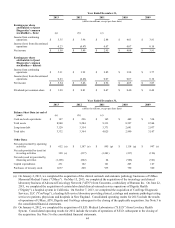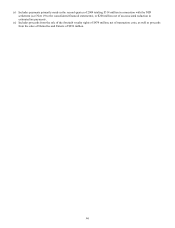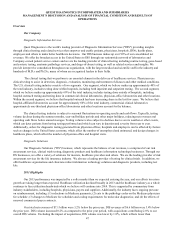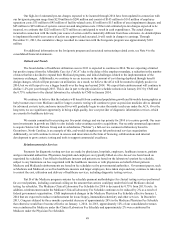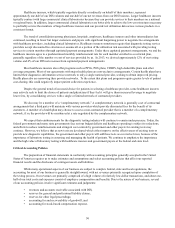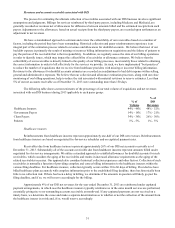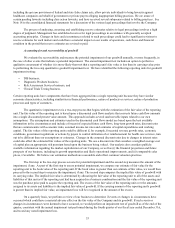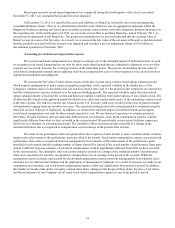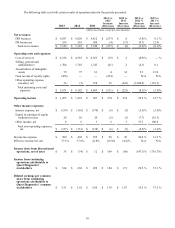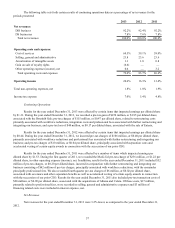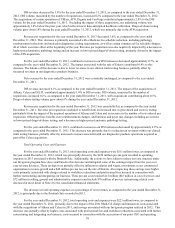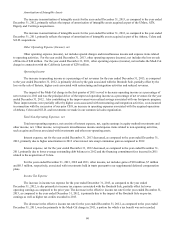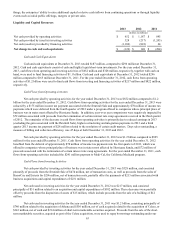Quest Diagnostics 2013 Annual Report Download - page 57
Download and view the complete annual report
Please find page 57 of the 2013 Quest Diagnostics annual report below. You can navigate through the pages in the report by either clicking on the pages listed below, or by using the keyword search tool below to find specific information within the annual report.53
including the qui tam provisions of federal and state false claims acts, allow private individuals to bring lawsuits against
healthcare companies on behalf of government or private payers alleging inappropriate billing practices. We are aware of
certain pending lawsuits including class action lawsuits, and have received several subpoenas related to billing practices. See
Note 18 to the consolidated financial statements for a discussion of the various legal proceedings that involve the Company.
The process of analyzing, assessing and establishing reserve estimates relative to legal proceedings involves a high
degree of judgment. Management has established reserves for legal proceedings in accordance with generally accepted
accounting principles. Changes in facts and circumstances related to such proceedings could lead to significant revisions to
reserve estimates for such matters and could have a material impact on our results of operations, cash flows and financial
condition in the period that reserve estimates are revised or paid.
Accounting for and recoverability of goodwill
We evaluate the recoverability and measure the potential impairment of our goodwill annually, or more frequently, in
the case of other events that indicate a potential impairment. The annual impairment test includes an option to perform a
qualitative assessment of whether it is more-likely-than-not that a reporting unit's fair value is less than its carrying value prior
to performing the two-step quantitative goodwill impairment test. We have identified the following reporting units for goodwill
impairment testing:
• DIS business;
• Diagnostic Products business;
• Risk Assessment Services business; and
• Clinical Trials Testing business.
Certain reporting units have components that have been aggregated into a single reporting unit because they have similar
economic characteristics, including similarities in financial performance, nature of products or services, nature of production
processes and types of customers.
The quantitative impairment test is a two-step process that begins with the estimation of the fair value of the reporting
unit. The fair value of the reporting unit is based upon a discounted cash flows analysis that converts future cash flow amounts
into a single discounted present value amount. This approach includes several unobservable inputs related to our own
assumptions. The assumptions and estimates used in the discounted cash flows model are based upon the best available
information in the circumstances and include a forecast of expected future cash flows, long-term growth rates, discount rates
that are commensurate with economic risks, assumed income tax rates and estimates of capital expenditures and working
capital. The fair values of the reporting units could be different if, for example, forecasted revenue growth rates, economic
conditions, government regulations or actions by payers to control utilization of or reimbursement for health care services, turn
out to be different than our assumptions or estimates. Changes in the assumed discount rates due to changes in interest rates
could also affect the estimated fair values of the reporting units. We use a discount rate that considers a weighted average cost
of capital plus an appropriate risk premium based upon the business being valued. Our analysis also considers publicly
available information regarding the market capitalization of our Company, as well as (i) the financial projections and future
prospects of our business, including its growth opportunities and likely operational improvements, and (ii) comparable sales
prices, if available. We believe our estimation methods are reasonable and reflect common valuation practices.
The first step in the two-step process screens for potential impairment and the second step measures the amount of the
impairment, if any. As part of the first step to assess potential impairment, we compare our estimate of fair value for the
reporting unit to the book value of the reporting unit. If the book value is greater than our estimate of fair value, we would then
proceed to the second step to measure the impairment, if any. The second step compares the implied fair value of goodwill with
its carrying value. The implied fair value is determined by allocating the fair value of the reporting unit to all of the assets and
liabilities of that unit as if the reporting unit had been acquired in a business combination and the fair value of the reporting unit
was the purchase price paid to acquire the reporting unit. The excess of the fair value of the reporting unit over the amounts
assigned to its assets and liabilities is the implied fair value of goodwill. If the carrying amount of the reporting unit's goodwill
is greater than its implied fair value, an impairment loss will be recognized in the amount of the excess.
On a quarterly basis, we perform a review of our business to determine if events or changes in circumstances have
occurred which could have a material adverse effect on the fair value of the Company and its goodwill. If such events or
changes in circumstances were deemed to have occurred, we would perform an impairment test of goodwill as of the end of the
quarter, consistent with the annual impairment test performed during the fourth quarter of our fiscal year ended December 31st,
and record any noted impairment loss.



